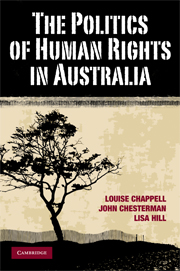Book contents
- Frontmatter
- Contents
- Acknowledgements
- List of abbreviations
- Introduction
- 1 Human Rights
- 2 Protecting Human Rights
- 3 A Bill of Rights?
- 4 Electoral Rights in Australia
- 5 The Rights of Indigenous Australians
- 6 Gender and Sexuality Rights
- 7 Refugees
- 8 Civil and Political Rights in an Age of Terror
- Notes
- Index
- References
4 - Electoral Rights in Australia
- Frontmatter
- Contents
- Acknowledgements
- List of abbreviations
- Introduction
- 1 Human Rights
- 2 Protecting Human Rights
- 3 A Bill of Rights?
- 4 Electoral Rights in Australia
- 5 The Rights of Indigenous Australians
- 6 Gender and Sexuality Rights
- 7 Refugees
- 8 Civil and Political Rights in an Age of Terror
- Notes
- Index
- References
Summary
Democracy is based on – even defined by – the political participation of citizens. The possession of suffrage rights is the key indicator of citizenship and is virtually synonymous with the concept of citizenship; from it flows all the other rights and freedoms enjoyed by inhabitants of democratic orders. Universal suffrage and the principle of one vote, one value are the key mechanisms by which legitimacy is conferred upon democratic states, therefore the right to vote for democratic representation, without discrimination, is rightly seen as a fundamental civil liberty in all systems that purport to be democratic and legitimate.
Political scientist Marian Sawer has described Australia as ‘the first nation created through the ballot box’, noting that ‘[m]uch of Australia's early identity as a nation revolved around its democratic experiments and the belief that while it was a young nation, it was a relatively old democracy’. Australia emerged as a nation not by revolution, ‘but at the ballot box through an exhausting round of referenda’. Throughout our electoral history ‘idealists have been at work’ creating not only a generally fair and accessible electoral system but also ‘a profession of dedicated professionals in electoral administration, at arms length from politicians and parties’ who are now in a position to provide democratic assistance to other nations, particularly those in democratic transition (Sawer 2001, 1, 26; Maley 2001).
- Type
- Chapter
- Information
- The Politics of Human Rights in Australia , pp. 85 - 116Publisher: Cambridge University PressPrint publication year: 2009



